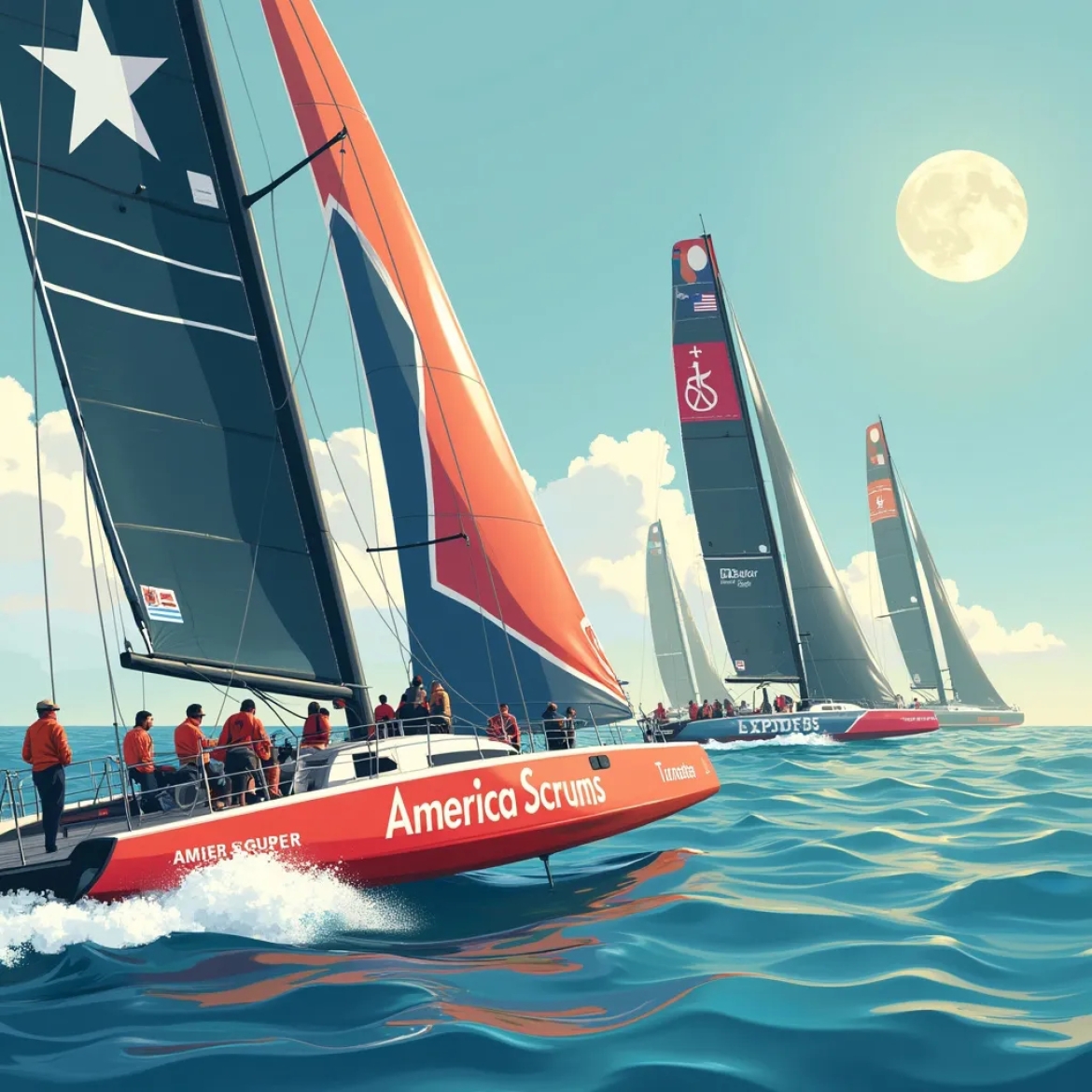Agile Scrum in the America's Cup / Louis Vuitton Cup Races: A New Frontier for Luna Rossa
In the dynamic and competitive world of sailing, adaptability and swift responsiveness are key success factors. Imagine if Luna Rossa, the prestigious Italian team, adopted the Agile Scrum methodology in the Louis Vuitton Cup races. What advantages could emerge from this innovative combination?
Roles in a Scrum Team:
- Product Owner
- Scrum Master
- Developers
Product Owner = Max Sirena (Skipper)
The Skipper is responsible for the overall strategy and leadership of the crew, similar to the Product Owner, who is responsible for the product vision and prioritization. Max Sirena, as Skipper, would therefore be the Product Owner, defining the project's objectives and priorities.
Scrum Master = Francesco Bruni and James Spithill (Helmsmen)
The Helmsmen steer the boat and coordinate maneuvers, ensuring that the crew works in harmony. This role is analogous to the Scrum Master, who facilitates the Scrum process, removes obstacles, and assists the team in adopting Agile practices. Francesco Bruni and James Spithill could share the role of Scrum Master, ensuring that the team follows the correct methodologies.
Developers = Trimmers + Cyclors
- Trimmers
The Trimmers are responsible for optimizing the sails, adjusting equipment to maximize performance. In the Scrum Team, they would be specialized developers, focused on specific tasks to improve the product.
- Cyclors
The Cyclors provide the necessary power through their physical strength, similar to the development team members who actively contribute to the product's realization. They work together to achieve objectives, bringing their skills to the team.
In this framework, each crew member assumes a role in the Scrum Team that reflects their responsibilities and expertise within the sailing team, facilitating a smooth transition to an Agile work environment.
Defining Each Race as a Sprint
By defining each race as a sprint, with clear and measurable objectives, the team can focus on optimal performance at every stage.
SPRINT PLANNING
Before each race, the Luna Rossa crew gathers for a strategic planning session.
During this meeting:
- Product Owner (Skipper): Presents the vision and objectives of the race, analyzing weather conditions, the course, and opponents' strategies.
- Scrum Masters (Helmsmen): Facilitate the discussion, ensuring that all members understand the plan and their responsibilities.
- Developers (Trimmers and Cyclors): Contribute technical input, highlighting available resources and possible operational limitations.
Example: They decide which maneuvers to execute, how to manage the sails based on the expected wind, and assign specific roles for critical situations during the race.
SPRINT BACKLOG
Definition: The Sprint Backlog is a list of activities and tasks that the team commits to completing during the sprint to achieve the predetermined goal.
Identification of the Sprint Goal (Race):
- Win the race.
- Execute efficient maneuvers.
- Maximize speed under all conditions.
- Quickly adapt to changes in wind and opponents' moves.
Creation of the Sprint Backlog:
- Analysis of Conditions:
- Evaluation of weather forecasts.
- Study of the course and buoys.
List of Key Activities:
- Effective Start:
- Optimal positioning on the starting line.
- Synchronization of the start time. - Crucial Maneuvers:
- Quick and coordinated tacks and gybes.
- Clear communication during maneuvers. - Sail and Power Management:
- Dynamic adjustment of sails based on the wind.
- Management of energy provided by the cyclors. - Navigation Strategies:
- Choosing the most advantageous routes.
- Reacting to opponents' strategies. - Assignment of Tasks:
- Helmsmen: Strategic guidance and decision-making.
- Trimmers: Optimization of sails.
- Cyclors: Providing constant power and managing energy resources.
Summary: The Sprint Backlog for the race includes all activities necessary to achieve the race's objective, with clear tasks assigned to team members.
IMPLEMENTATION
Minutes 0-5 (Start):
- Implementation of the Start Plan:
- Positioning on the starting line according to strategy.
- Constant communication to synchronize the exact moment of the start.
Minutes 5-15 (First Navigation Phase)
- Adapting to Actual Conditions:
- Trimmers: Adjust sails based on the actual wind.
- Cyclors: Provide adequate power to maintain speed. - Communications (Similar to the Daily Scrum):
- Helmsmen: "How are we doing compared to the opponents?"
- Team: Report on performance and suggestions for improvement.
Minutes 15-25 (Maneuvers and Strategies)
- Execution of Key Maneuvers:
- Preparation for tacks and gybes.
- Detailed coordination to minimize loss of speed. - Quick Updates:
- Reporting Obstacles:
- "Wind decreasing, let's adjust the sails."
- "Opponent approaching, should we change course?"
Minutes 25-30 (Final Phase)
- Maximizing Performance:
- All members focused on crossing the finish line first.
- Cyclors: Increase power input for the final effort. - Last Updates:
- Helmsmen: "Maintain course; we're ahead."
- Team: Confirmation and focus on the final objective.
Daily Stand-up Meeting (Daily Scrum)
Definition: The Daily Scrum is a brief meeting where the team aligns on the work done, plans for the next hours, and identifies any obstacles.
Even though there isn't a formal "Daily Scrum" during the race, communications among crew members serve as constant updates on the status of activities.
Examples of Communications:
- Helmsmen: "Wind increasing, prepare for adjustments."
- Trimmers: "Sails optimized; we could gain speed."
- Cyclors: "Maximum power for the next 2 minutes."
SPRINT REVIEW
After the conclusion of the race:
- Presentation of Results: The crew analyzes performance relative to the objectives established during Sprint Planning.
- Practical Demonstration: They review video recordings of the race, analyzing maneuvers and tactical decisions.
- Feedback from Stakeholders: They share results with the coach and technical team to obtain further input.
Example: They discuss how a specific maneuver allowed them to gain an advantage over opponents or how a decision influenced the final result.
SPRINT RETROSPECTIVE
The goal is to continuously improve internal processes:
- Reflection on the Process: The team discusses what went well and what could be improved in team dynamics.
- Identification of Areas for Improvement: Needs for more effective communication or additional training on specific maneuvers may emerge.
- Action Plan for Future Improvements: They establish concrete actions to implement in the next race or training cycle.
Example: The team might recognize the need to develop clearer signals between trimmers and cyclors during critical phases.
Why Could This Integration Make a Difference?
In the competitive context of the America's / Louis Vuitton Cup, where the margins between victory and defeat are thin, adopting Agile methodologies could offer the necessary strategic advantage. It could improve team cohesion, increase operational efficiency, and stimulate a virtuous cycle of continuous improvement.
Author: Agile Scrum Master - Claudio Restaino
#LunaRossa #AgileScrum #LouisVuittonCup #Innovation #Sailing #Teamwork #ContinuousImprovement







